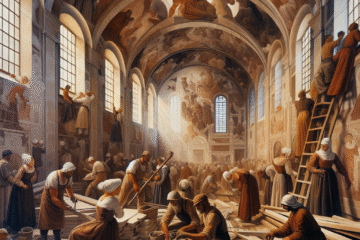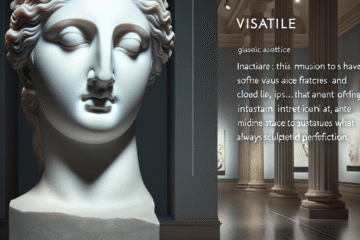I. Introduction
A. Explanation of Cubism and its significance
Cubism was an influential and revolutionary art movement that emerged in the early 20th century. It is characterized by the breaking down of reality into geometric shapes, use of multiple perspectives and viewpoints, and a monochromatic color palette. Cubism challenged traditional notions of representation and perspective in art and opened up new avenues for artistic expression.
Cubism was a major turning point in the history of modern art, and its influence can still be felt today. It marked a break from the representational and impressionistic styles that had dominated Western art for centuries and paved the way for subsequent art movements such as Surrealism and Abstract Expressionism.
B. Brief history of Cubism and its founders
Cubism was founded by Pablo Picasso and Georges Braque, two artists working in Paris in the early 20th century. The movement emerged around 1907 and lasted until around 1914. During this time, Picasso and Braque developed a new way of seeing and representing the world, which they called “Cubism”.
The term “Cubism” was coined by the art critic Louis Vauxcelles, who described Braque’s work as “reduced to geometric outlines, to cubes”. The name stuck, and the movement became known as Cubism.
Picasso and Braque worked closely together during the early years of Cubism, and their work was often indistinguishable. They experimented with different techniques and materials, using a variety of media to create their art.
Other artists soon joined the Cubist movement, including Juan Gris and Fernand Léger. The movement quickly spread beyond France, and Cubist exhibitions were held in major cities throughout Europe and the United States.
Cubism had a significant impact on the art world and on broader cultural trends. Its influence can be seen in everything from design and architecture to fashion and advertising. Today, Cubism is recognized as one of the most important and influential art movements of the 20th century.
II. Origins of Cubism
A. Explanation of the cultural and artistic context of the early 20th century
Cubism emerged in the early 20th century, during a time of rapid change and upheaval in Western society. The world was in the midst of an industrial revolution, and new technologies and modes of communication were transforming daily life.
In the art world, there was a growing sense of dissatisfaction with traditional forms of representation. Artists were looking for new ways to capture the rapidly changing world around them, and to express the complex emotions and ideas of the modern era.
B. Influences of African and Oceanic art on Cubism
One of the key influences on Cubism was the art of Africa and Oceania. In the late 19th and early 20th centuries, European collectors and artists became increasingly interested in the art and artifacts of these regions, which were seen as exotic and primitive.
African and Oceanic art was characterized by its abstract and geometric forms, as well as its emphasis on masks and other objects used in ritual ceremonies. These art forms challenged traditional Western notions of representation and perspective, and had a profound impact on the development of modern art.
Picasso and Braque were particularly drawn to the abstract forms and stylized figures of African and Oceanic art. They incorporated these influences into their own work, using geometric shapes and distorted forms to create a new kind of art that was simultaneously abstract and representational.
C. The influence of Cézanne’s post-impressionist style on Cubism
Another major influence on Cubism was the post-impressionist paintings of Paul Cézanne. Cézanne was known for his use of bold colors and simplified forms, and his work paved the way for the development of modern art.
Picasso and Braque were particularly drawn to Cézanne’s approach to perspective, which emphasized the two-dimensional nature of the canvas. They also admired his use of geometric forms and flattened space.
Incorporating these ideas into their own work, Picasso and Braque began to break down the forms of the natural world into simple geometric shapes. They experimented with multiple viewpoints and fragmented perspectives, creating a new kind of art that challenged traditional notions of representation and perspective.
In conclusion, the origins of Cubism are rooted in the cultural and artistic context of the early 20th century. Influences from African and Oceanic art, as well as the post-impressionist style of Cézanne, played a significant role in the development of this revolutionary art movement. By incorporating these ideas into their own work, Picasso, Braque, and other Cubist artists opened up new avenues for artistic expression and changed the course of modern art.
III. Characteristics of Cubism
Cubism is a revolutionary art movement that emerged in the early 20th century. It is characterized by a number of distinctive features, including the breaking down of reality into geometric shapes, use of multiple perspectives and viewpoints, emphasis on the flatness of the canvas, and a monochromatic color palette. In this article, we will explore each of these characteristics in more detail.
A. Breaking down of reality into geometric shapes
One of the defining features of Cubism is the way it breaks down the forms of the natural world into simple geometric shapes. Rather than trying to represent objects realistically, Cubist artists sought to capture the essence of the object by reducing it to its basic geometric forms.
This approach allowed Cubist artists to create a new kind of art that was simultaneously abstract and representational. By breaking down reality into its component parts, they were able to create a new kind of visual language that was both innovative and challenging.
B. Use of multiple perspectives and viewpoints
Another key feature of Cubism is the use of multiple perspectives and viewpoints. Rather than depicting an object from a single vantage point, Cubist artists would show multiple viewpoints of the same object, as if they were seeing it from different angles simultaneously.
This approach challenged traditional notions of perspective and representation in art, and allowed Cubist artists to create a new kind of visual language that was more in line with the complex and dynamic nature of the modern world.
C. Emphasis on the flatness of the canvas
In Cubism, there is a strong emphasis on the flatness of the canvas. Rather than creating the illusion of depth and space, Cubist artists sought to emphasize the two-dimensional nature of the canvas.
This approach allowed Cubist artists to create a new kind of visual language that was more in line with the flat and fragmented nature of the modern world. By breaking down the forms of the natural world into simple geometric shapes and emphasizing the flatness of the canvas, they were able to create a new kind of art that was more in line with the complexities of the modern era.
D. Monochromatic color palette
Finally, Cubism is characterized by a monochromatic color palette. Rather than using a wide range of colors, Cubist artists would often limit themselves to a single color or a small range of colors.
This approach allowed Cubist artists to focus more on form and structure, and to create a more unified and cohesive visual language. It also allowed them to create a more abstract and stylized version of reality, which was more in line with the challenges of the modern era.
In conclusion, Cubism is a revolutionary art movement that is characterized by a number of distinctive features. From the breaking down of reality into geometric shapes to the use of multiple perspectives and viewpoints, Cubist artists sought to create a new kind of visual language that was more in line with the complex and fragmented nature of the modern world. By emphasizing the flatness of the canvas and using a monochromatic color palette, they were able to create a more abstract and stylized version of reality, which challenged traditional notions of representation and perspective in art.
IV. Evolution of Cubism
Cubism was a revolutionary art movement that emerged in the early 20th century and had a significant impact on the development of modern art. Over the course of its relatively brief history, Cubism evolved and diversified, giving rise to a number of different styles and approaches. In this article, we will explore the evolution of Cubism and the different forms it took.
A. Analytic Cubism: Breaking down objects into smaller, more abstract forms
Analytic Cubism is the earliest form of Cubism, and it is characterized by its emphasis on breaking down objects into smaller, more abstract forms. In this style, Cubist artists would analyze an object from multiple perspectives and viewpoints, and then break it down into its component parts. These parts would then be reassembled in a highly abstract and stylized form.
Analytic Cubism is characterized by its monochromatic color palette, which emphasizes form and structure over color. This style was highly influential and paved the way for the development of subsequent forms of Cubism.
B. Synthetic Cubism: Incorporating everyday objects and materials into artwork
Synthetic Cubism is the second major form of Cubism, and it is characterized by its use of everyday objects and materials in artwork. In this style, Cubist artists would incorporate materials such as newspapers, wallpaper, and sheet music into their artwork, creating a new kind of visual language that was more in line with the complexities of the modern world.
Synthetic Cubism is also characterized by its use of color, which is more vibrant and varied than the monochromatic palette of Analytic Cubism. This style was highly innovative and had a significant impact on subsequent art movements.
C. Other forms of Cubism: Orphism, Purism, and Futurism
In addition to Analytic and Synthetic Cubism, there were a number of other forms of Cubism that emerged during the early 20th century. Orphism was a form of Cubism that emphasized the use of vibrant colors and harmonious compositions. Purism was a form of Cubism that emphasized the use of simple, geometric forms and a focus on the functional and utilitarian aspects of everyday objects.
Finally, Futurism was a form of Cubism that was characterized by its focus on movement, speed, and technology. This style was highly innovative and had a significant impact on subsequent art movements, including Surrealism and Abstract Expressionism.
In conclusion, Cubism was a revolutionary art movement that evolved and diversified over the course of its relatively brief history. From the early Analytic Cubism to the later Synthetic Cubism and other forms such as Orphism, Purism, and Futurism, Cubism had a profound impact on the development of modern art. By breaking down the forms of the natural world into smaller, more abstract forms and incorporating everyday objects and materials into artwork, Cubist artists created a new kind of visual language that was more in line with the complexities of the modern era.
V. Major Artists of Cubism
Cubism was a revolutionary art movement that emerged in the early 20th century and had a significant impact on the development of modern art. Over the course of its relatively brief history, a number of important artists played a key role in the development and evolution of Cubism. In this article, we will explore some of the major artists of the Cubist movement.
A. Pablo Picasso and Georges Braque
Pablo Picasso and Georges Braque were the founders of Cubism and two of the most important figures in the development of the movement. They worked closely together during the early years of Cubism, and their work was often indistinguishable. They experimented with different techniques and materials, using a variety of media to create their art.
Picasso was particularly drawn to African and Oceanic art, which he incorporated into his work to create a new kind of art that was simultaneously abstract and representational. Braque, on the other hand, was more focused on the geometric forms and stylized figures of Cézanne’s post-impressionist style.
Together, Picasso and Braque developed a new way of seeing and representing the world, which they called “Cubism”. Their influence on the development of modern art cannot be overstated.
B. Juan Gris and Fernand Léger
Juan Gris and Fernand Léger were two other important artists of the Cubist movement. Gris was known for his use of color and his incorporation of collage and other materials into his artwork. Léger was known for his use of machine-like forms and his focus on the functional and utilitarian aspects of everyday objects.
Gris and Léger both played a key role in the evolution of Cubism, pushing the boundaries of the movement and experimenting with new techniques and approaches. Their work was highly innovative and had a significant impact on the development of modern art.
C. Other significant artists of the Cubist movement
In addition to the major figures of Picasso, Braque, Gris, and Léger, there were a number of other important artists who played a key role in the development of Cubism. These included Robert Delaunay, Francis Picabia, and Marcel Duchamp, among others.
Each of these artists brought their own unique perspective and approach to Cubism, pushing the boundaries of the movement and experimenting with new techniques and materials. Their work had a significant impact on the development of modern art, and their influence can still be felt today.
In conclusion, the major artists of the Cubist movement were some of the most innovative and influential figures in the history of modern art. From the founders of the movement, Picasso and Braque, to the innovative approaches of Gris and Léger, these artists pushed the boundaries of the movement and opened up new avenues for artistic expression. Their work had a profound impact on the development of modern art, and their influence can still be seen today in contemporary art and design.
VI. Legacy of Cubism
Cubism was a revolutionary art movement that emerged in the early 20th century and had a profound impact on the development of modern art. Over the course of its relatively brief history, Cubism influenced subsequent art movements, impacted popular culture, design, and architecture, and continues to be relevant and important in contemporary art. In this article, we will explore the legacy of Cubism.
A. Influence on subsequent art movements such as Surrealism and Abstract Expressionism
Cubism was a major influence on subsequent art movements such as Surrealism and Abstract Expressionism. The abstract forms, multiple perspectives, and use of collage and other materials in Cubist art were taken up and expanded upon by these later movements.
Surrealist artists such as Salvador Dali and Max Ernst were particularly drawn to the idea of the unconscious and the dream-like qualities of Cubist art. Abstract Expressionists such as Jackson Pollock and Mark Rothko were inspired by the expressive potential of Cubist techniques and the way they could be used to create a new kind of art that was both abstract and emotive.
B. Impact on popular culture, design, and architecture
Cubism also had a significant impact on popular culture, design, and architecture. The angular forms and geometric shapes of Cubist art were incorporated into everything from furniture and textiles to buildings and cityscapes.
The influence of Cubism can be seen in the designs of modernist architects such as Le Corbusier and Ludwig Mies van der Rohe, who used geometric forms and clean lines to create a new kind of architecture that was functional and utilitarian.
In addition, the influence of Cubism can be seen in the design of everyday objects, from clothing and accessories to household items and appliances. The aesthetic of Cubism continues to be a source of inspiration for designers and artists today.
C. Continued relevance and importance in contemporary art
Despite its relatively brief history, Cubism continues to be relevant and important in contemporary art. The abstract forms, multiple perspectives, and use of collage and other materials in Cubist art continue to inspire artists working in a wide range of media.
Contemporary artists such as David Hockney, Gerhard Richter, and Julian Schnabel have all been influenced by Cubism, using its techniques and aesthetic to create new and innovative works of art.
In conclusion, the legacy of Cubism is vast and far-reaching. From its influence on subsequent art movements such as Surrealism and Abstract Expressionism to its impact on popular culture, design, and architecture, Cubism continues to be relevant and important in contemporary art. Its innovative techniques and aesthetic continue to inspire artists and designers today, making it one of the most significant and enduring art movements of the 20th century.
VII. Conclusion
Cubism was a revolutionary art movement that emerged in the early 20th century and had a significant impact on the development of modern art. From its origins in the work of Picasso and Braque to its evolution and diversification into various forms such as Analytic and Synthetic Cubism, Orphism, Purism, and Futurism, Cubism pushed the boundaries of traditional art and opened up new avenues for artistic expression.
The significance and impact of Cubism cannot be overstated. Cubism challenged traditional notions of representation and perspective in art, and introduced a new visual language that was more in line with the complexities of the modern era. By breaking down the forms of the natural world into smaller, more abstract forms and incorporating everyday objects and materials into artwork, Cubist artists created a new kind of visual language that was simultaneously abstract and representational.
The legacy of Cubism is vast and enduring. Its influence can be seen in subsequent art movements such as Surrealism and Abstract Expressionism, as well as in popular culture, design, and architecture. The enduring relevance and importance of Cubism in contemporary art is a testament to its innovative techniques and aesthetic, which continue to inspire artists and designers today.
In conclusion, Cubism was one of the most significant and influential art movements of the 20th century. Its impact on the development of modern art cannot be overstated, and its legacy continues to be felt in contemporary art and design. From its innovative techniques and aesthetic to its enduring influence on subsequent art movements and popular culture, Cubism remains a revolutionary force in the world of art.


